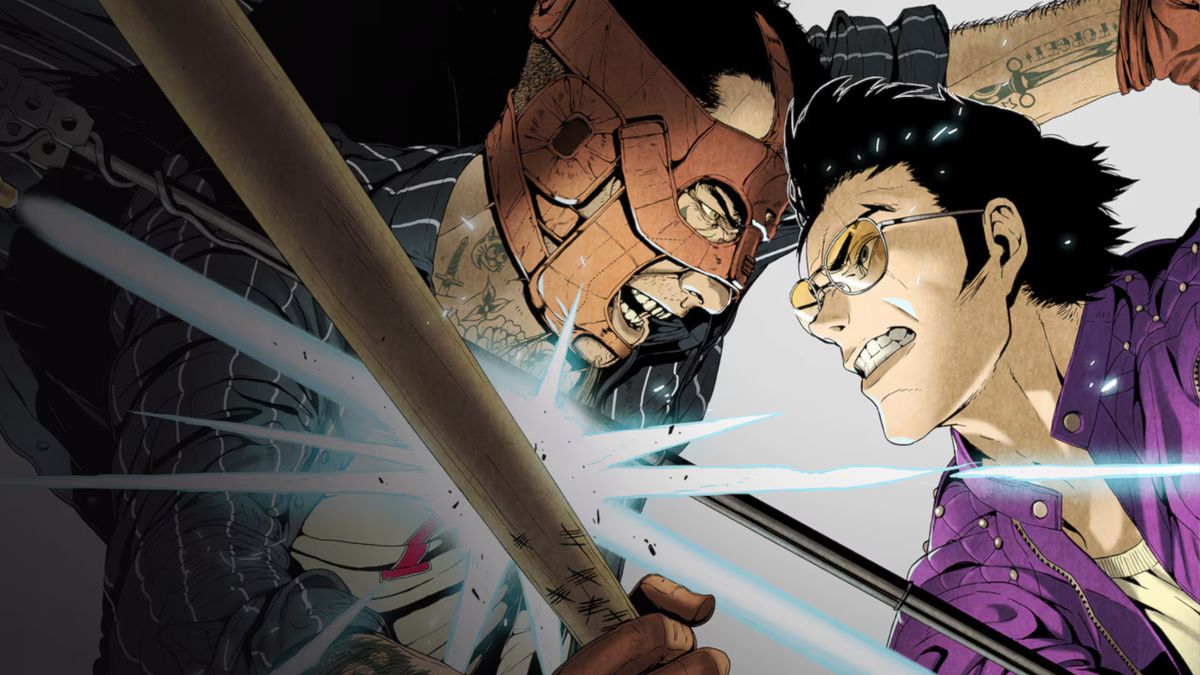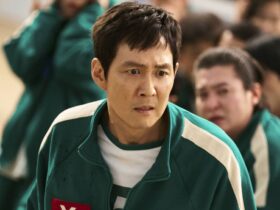To know Goichi “Suda51” Suda’s work is to also know its reputation. His portfolio of games all have rough edges and a prickly spirit, but are all endearing as a result. There’s a punk edge about them that rebels against the extreme levels of polish that sand down the corners of the biggest blockbuster games. Simply put, Suda51 creates cult classics. Whether it’s the strangeness of Killer7’s world and shooting system; the beam katana hyperviolence of No More Heroes’ world of ranked assassins; or the gory cases of The Silver Case’s Heinous Crimes Unit; every game has impact.
How did Suda51 get here? Start, as they say, as you mean to go on. Entering the industry with Human Entertainment’s Fire Pro Wrestling series, he served as director on Super Fire Pro Wrestling Special in 1994, as well as being the scenario writer. SNES fighters were best known for simplistic victory screens and straightforward stories. But here, it saw hero Morio Sumisu so beaten down by the events of the game, even in victory, that it ends with the character taking his own life. It would be a shocking ending for a game now, let alone in the early ’90s. But it was compelling, and remains so even to this day.
Suda51 tells me he still remembers the development of that finale well. “I grew up reading a lot of sports based manga, for example, like Tiger Mask,” he shares. “Originally, it was mainly, you know, a more mechanic-based wrestling game, and I wanted to do something more with it. I wanted to make it into more of a story-heavy, story-focused game.”

“I ate a lot of shit for the way that I decided to end the game.”
The original concept was to have multiple endings. “Put really simply, a happy ending where Morio Sumisu becomes World Champion, and a bad ending, where he loses,” says Suda51. “But, I thought really long and hard about what exactly I wanted to do with the game, and the direction I wanted to take it.”
World events affected where he landed with it. “For example, that was the same year that Kurt Cobain [died by] suicide, things like that,” he continues. “I decided, okay, instead of having the really kind of stereotypical happy ending and bad ending, I want to make sure that the story has an actual complete ending. […] I decided to, for better or for worse, for both the character and the players, to take it in that direction and make a more definitive end.”
Not everyone loved it. But it was bold. And, most importantly, this was a SNES game actually trying to say something – rare in a line-up where mechanics often ruled over storytelling. “When we originally put the game out, there were some really mixed feelings on how it turned out,” shares Suda51. “A lot of people were really pissed off. I ate a lot of shit for the way that I decided to end the game.”
Case files

Thankfully, Suda51 was able to take that energy forward into a different genre, pivoting from his beloved wrestling (almost every game he works on references the electrifying form of entertainment) to adventure games in a visual novel style with Twilight Syndrome and Moonlight Syndrome. It was a jump Suda51 was keen to make. “I decided that I want to make games that are a bit more involving and have a bit more depth to them, and something that’s a bit more worth getting into for the player.”
Shortly after, Suda51 founded Grasshopper Manufacture in 1998. It’s the studio he leads to this day. Their debut title, The Silver Case, was a narrative-heavy title in the mold of Suda51’s other mystery work. With a near-future setting, it centers around the resurgence of a grisly serial killer and follows two simultaneous story strands: Transmitter, and Placebo, which can be played out of order. The former, written by Suda51, is about detectives from the Heinous Crime Unit solving the cases; while the latter is about reporter Tokio, written by Masahi Ooka (and Sako Kato). But there’s plenty of crossover, including some quite off-putting and ominous moments where one thread bleeds into another.
“That sort of vibe in general wasn’t really something that was planned out, it was something that sort of happened organically,” shares Suda51. “We were both sort of bouncing off each other with this stuff.” The main goal was to make a “crime suspense genre type game” and to let the creative juices flow from there. It worked, and the text-heavy format allowed Suda51 plenty of creative experimentation.

Dial NMH for…

“I immediately set out to create a full action game that could take advantage of this unique controller, and No More Heroes was born.” We interview Suda51 about the original release!
A game’s narrative and its characters form the beating heart of what Suda51 is interested in exploring with his games, no matter how over-the-top the action or violence. With the likes of No More Heroes, hyper-violent action has become another constant in his portfolio. “Every story, regardless of the genre, [has] its own backbone,” says Suda51 about No More Heroes: Travis Strikes Again. “I feel there are parts particularly for action and adventure type games, that it’s just sort of hard to express the true backbone of the story that you’re trying to tell only through visuals.” He also admits it costs a lot less money to use text-heavy elements to explore this detail, rather than getting bogged down in really expensive development avenues for what can be conveyed through the more old school style.
I can’t help but ask – given he’s still very much in love with the format – if he’s thought about returning to more visual novel-like, narrative focused game development? “To be honest, particularly recently, I have thought about it several times. I kind of do think about it a lot,” says Suda51.
The current slate of Grasshopper Manufacture games he doesn’t consider “triple-A” but closer to “double A” or even “A”, which Suda51 thinks about when considering what’s possible to develop for the studio. “I’ve always had a real soft spot for indie games. I like making games on a slightly smaller scale. And also, there’s just something about, not necessarily purely visual novels, but more text heavy games and more story heavy games that really appeals to me,” he continues. “Not only are they able to be made with a smaller, more, I guess you could say consolidated, closer core team, but it’s also, in some ways, a much easier medium in which to tell the story that you want to tell in the way that you want to tell it.” While he says that doesn’t necessarily mean he’ll be making visual novels per se, he’d like to do “something that’s a bit more text heavy and a lot more story focused than just straight up action or action-adventure. […] it’s definitely something that I’ve been thinking a lot more about the past few years, yeah.”
Getting into the action

On the face of it, Suda51 and Grasshopper Manufacture jumping from story-first games The Silver Case and Flower, Sun, and Rain, to action-heavy titles like Killer7 and No More Heroes seems like a drastic shift.
“More so than adapting to the market, it was more a matter of adapting the kind of games that we made to the kind of games that we were able to make in accordance with the size of our studio,” says Suda51. Beginning with three employees, Grasshopper Manufacturer quickly ballooned in staff size. “We kind of grew more from text heavy stuff to 3D, and from there on to more action-adventure games over a period of about 10 years or so.”
But, Suda51’s love of stories and characters has remained a core part of the studio’s action games. Killer7 has lots of violent shooting, but having a protagonist who literally transforms into a collection of different, world-renowned assassins is all about character. And it’s the same for No More Heroes, where protagonist Travis Touchdown must slay his way to the top of a killer-for-hire league table. Though there is a fun, tongue-in-cheek moment at the end of where a completely voice acted but lengthy explanation of the complicated backstory is played on extreme fast-forward.

“Part of it was making fun of myself and that sort of genre.”
Suda51 still remembers the infamous scene well. “It just ended up getting really long! And I didn’t want to cut it out because it was all really important stuff.” But also, he says, “This shit is expensive. Even back in the Wii days.” Putting heads together with animation studio Shirogumi they hit upon the solution of including it, but speeding it up, so it would be there for people who wanted it without having to be excessively detailed.
“It was kind of a win-win situation,” says Suda51. “We were able to make sure everything was probably explained, but at the same time, you’re not just sitting there, holding your controller for like 15 minutes [like] ‘Okay, come on, man, whatever, man, just begin the fucking fight.'” It worked for the cadence the developer was looking for, but he admits that “Part of it was making fun of myself and that sort of genre.”
Being self-aware is a large part of Suda51’s work. Rather than feeling cringe, it comes across more as wanting to meet the player on their own terms, and being very aware of the relationship between creator and those engaging with the material. Playing in that space, and messing with expectations, is a hallmark of his style. And it means we never know quite what we can expect next. Before I ask him about the future, and dig deeper into his game development process – I’ll keep holding out for more on a possible return to narrative-focused gaming. But I’m sure no matter what I can imagine, it’ll end up being something very different instead.
Nobody’s perfect! Especially Travis Touchdown. As geeky and delusional as he may be, No More Heroes’ antihero is one of the best assassins of all time.












Leave a Reply